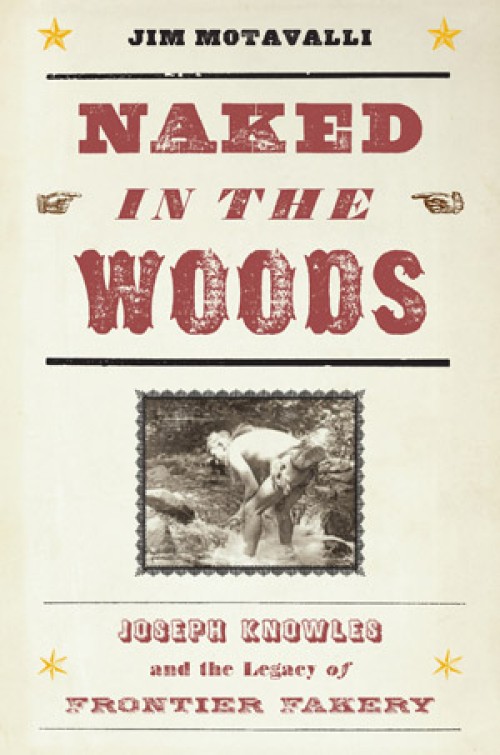by By Jim Motavalli
Da Capo Press, 2007
On August 13, 1913, Joe Knowles, without clothing, shoes, tools, or food, walked into the woods near Eustis, Maine, for a two-month publicity stunt that pitted man against the elements. For the next two months, he would keep the world apprised of his fortunes and adventures via a series of penned missives in charcoal on birch bark, fed directly into the maw of the Boston Post’s publicity machine.
Jim Motavalli’s Naked in the Woods chronicles the life and exploits of Knowles, an ex-sailor, hunting guide, painter, actor, possible fraud, and, finally, a pawn in the legendary battles for readership of the nation’s powerful newspapers. Knowles’s North Woods caper was followed by a similar stunt in northern California, the news value of which was eclipsed by the coincidental outbreak of World War I. With a spell in Hollywood, Knowles’s flavor of wilderness feats devolved into a tabloid tale: in 1916, Knowles, then 46, and Elaine Hammerstein, the beautiful 20-year-old scion of the famous Hammerstein family, were headed for another naked, fend-for-yourself foray, this time into the wild Adirondacks. Hammerstein, who was chosen for this role by none other than William Randolph Hearst, was referred to as Dawn Woman; Knowles was Dawn Man. Unfortunately, Dawn Woman, after a short apprenticeship with Knowles that involved sleeping under the stars in the grass clothing and shelter she had made under his tutelage, thought better of the whole enterprise and headed back to New York.
What makes the life of Joe Knowles so interesting is not so much his exploits, which sound all too much like the reality shows of today, but why people found him interesting in the second decade of the twentieth century. Motavalli frames his curious tale with ample background on the sociological ills of the times. With the taming of the West and the movement of large segments of the population off the farm and into the rhythm of factory work and city life, Americans were becoming increasingly concerned about their lack of exposure to nature and the skills it requires of us. Knowles wrote in his book Alone in the Wilderness, a chronicle of his Maine adventure, “Today, all kinds of luxury surrounds the average boy.” Boy Scouting began in this era, and Jack London’s Call of the Wild was the most popular novel of the times. Knowles was viewed by many as a modern-day Davy Crockett, Daniel Boone, or Mike Fink, at a time when the heroes of the fading West had lost their luster. On the other hand, there were plenty who believed Knowles to be nothing but a “nature faker,” a term coined by naturalist John Burroughs, who along with rough rider, outdoorsman, conservationist, and President Teddy Roosevelt, deplored the nature experts of the times who were “all hat and no cattle,” as they say.
The controversy that surrounds the authenticity of Knowles’s exploits is a major part of Naked in the Woods. Knowles’s first chronicled foray into the wilds of Maine was spent eating beans and drinking beer in a comfortable cabin by the side of a lake close to the spot in the woods where he built a shelter (according to Knowles’s accuser, the cabin had a large pile of food cans and beer bottles behind it). Knowles claims to have killed a small bear for its pelt and found a deer killed by a wildcat, which he used to make some rudimentary leggings. He even left some “put up” food in the lean-to he had constructed. But he finished his two months in the woods by emerging 40 miles east in Megantic, Quebec. Some say he had to hike there to work off the weight he put on drinking beer and eating beans for two months. Others say he emerged in Megantic to elude Maine game wardens, who knew he had taken a bear out of season. Or did he? Who knows? But it sure makes a fine tale.


